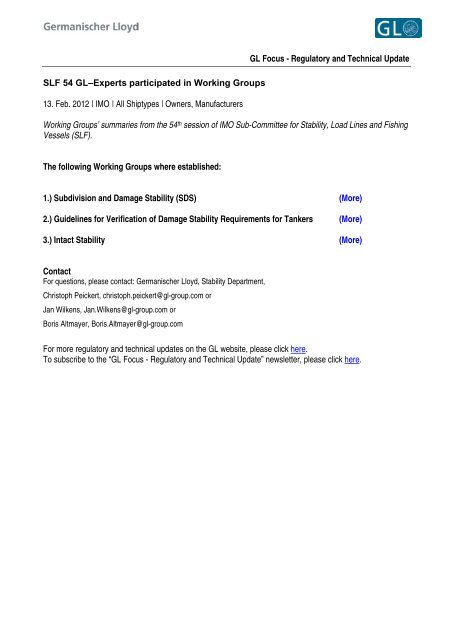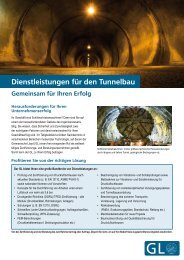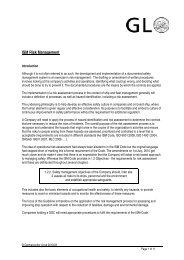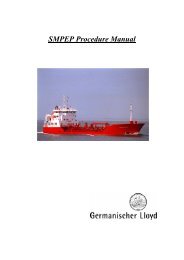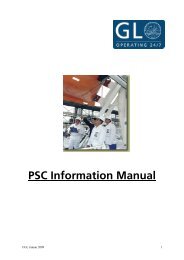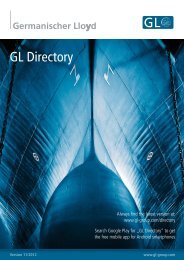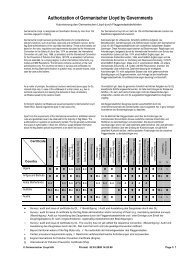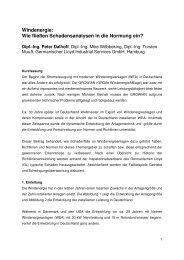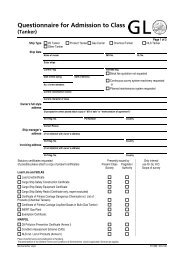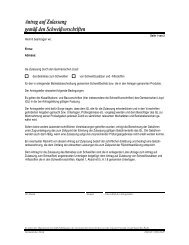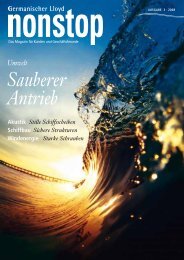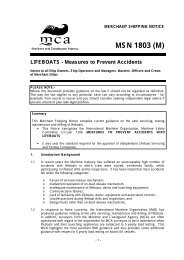Tokyo MOU and Paris MOU Announce Inspection ... - GL Group
Tokyo MOU and Paris MOU Announce Inspection ... - GL Group
Tokyo MOU and Paris MOU Announce Inspection ... - GL Group
Create successful ePaper yourself
Turn your PDF publications into a flip-book with our unique Google optimized e-Paper software.
SLF 54 <strong>GL</strong>–Experts participated in Working <strong>Group</strong>s<br />
13. Feb. 2012 | IMO | All Shiptypes | Owners, Manufacturers<br />
<strong>GL</strong> Focus - Regulatory <strong>and</strong> Technical Update<br />
Working <strong>Group</strong>s’ summaries from the 54 th session of IMO Sub-Committee for Stability, Load Lines <strong>and</strong> Fishing<br />
Vessels (SLF).<br />
The following Working <strong>Group</strong>s where established:<br />
1.) Subdivision <strong>and</strong> Damage Stability (SDS) (More)<br />
2.) Guidelines for Verification of Damage Stability Requirements for Tankers (More)<br />
3.) Intact Stability (More)<br />
Contact<br />
For questions, please contact: Germanischer Lloyd, Stability Department,<br />
Christoph Peickert, christoph.peickert@gl-group.com or<br />
Jan Wilkens, Jan.Wilkens@gl-group.com or<br />
Boris Altmayer, Boris.Altmayer@gl-group.com<br />
For more regulatory <strong>and</strong> technical updates on the <strong>GL</strong> website, please click here.<br />
To subscribe to the “<strong>GL</strong> Focus - Regulatory <strong>and</strong> Technical Update” newsletter, please click here.
1.) Subdivision <strong>and</strong> Damage Stability (SDS)<br />
<strong>GL</strong> Focus - Regulatory <strong>and</strong> Technical Update<br />
Within the Working group on SDS (Subdivision <strong>and</strong> Damage Stability) considerable progress on a number of<br />
items was made.<br />
Under the agenda item “Safe Return to Port” it was agreed that the calculation procedure for cross-flooding<br />
arrangements shall be revised based on input from several research projects. For on-board loading computers<br />
which include a damage stability module, a specific need to re-open the discussion to clarify the application<br />
method was identified. Such a damage module may be helpful for the crew in case of casualties; therefore the<br />
accuracy of the module was addressed as being of high importance.<br />
With respect to RoRo passenger ships there is an ongoing discussion on the applicable safety level. Several<br />
research projects are comparing the safety level of the present SOLAS 2009 regulations with those of the<br />
former SOLAS under special consideration of the Stockholm Agreement (“Water on deck”). It was found<br />
necessary to wait for the outcome <strong>and</strong> results of such research projects (GOLADS, FloodSt<strong>and</strong>, EMSA(2),<br />
RP625) in order to consider their results for the future discussion.<br />
Further on, there where considerations related to the damage stability st<strong>and</strong>ard for OSV vessels. An<br />
amendment to the existing OSV Code was proposed to have vessels with a length of over 100m complied with<br />
the probabilistic damage requirements according to SOLAS 2009. Vessels between 80 <strong>and</strong> 100m in length<br />
shall be allowed to choose whether to apply the deterministic approach of the OSV Code or alternatively the<br />
probabilistic method.<br />
A considerable amount of time was used for the revision of SOLAS 2009 <strong>and</strong> Explanatory Notes. It was<br />
clarified that also for smaller cargo ships with a length of less than 80m the arrangement of a double bottom is<br />
required. Alternatively equivalent protection may be verified by a calculation procedure. A proposed<br />
methodology for such a calculation procedure is available but has to be developed in more detail.<br />
Further on the arrangement of the well for lubricating oil under main engines in relation to the double bottom<br />
protection was discussed. The present method showing equivalent protection by applying the calculation<br />
procedure acc. to Reg. 9.8 was added with the option to arrange such a well with a vertical distance of h/2 to<br />
the keel line.<br />
During certain operations a vessel can operate with drafts less than the “Light Service Condition” (e.g. during<br />
ballast water exchange) or in excesses of the summer load line draft (e.g. on tropical draft). A procedure was<br />
developed <strong>and</strong> agreed to include such draft ranges for the stability limiting curve.<br />
Continuing, related to the stability limiting curve, it was addressed that a trim limitation is valid based on the<br />
damage stability calculation according to SOLAS 2009. A corresponding procedure for the calculation process<br />
<strong>and</strong> also for the onboard use was agreed.<br />
Regulation 4 of the present SOLAS 2009, chapter II-1 defines the applicability of the subdivision <strong>and</strong> damage<br />
st<strong>and</strong>ard. Herein a footnote is included which lists certain codes describing alternative damage stability<br />
st<strong>and</strong>ards. It was noted that the footnote entails a different legal status than that of the regulation text itself.<br />
Therefore a revised wording for SOLAS II-1Reg. 4 was prepared. It is assumed that the discussion on this item<br />
will continue as several delegations have raised concerns about the wording <strong>and</strong> following implementation of<br />
the revised text.<br />
The anticipated completion date for most of the items discussed within the SDS <strong>Group</strong> will be in the next (SLF<br />
55) meeting <strong>and</strong> the following enforcement will be at MSC 92 which will probably be held in May 2013.
2.) Guidelines for Verification of Damage Stability Requirements for Tankers<br />
<strong>GL</strong> Focus - Regulatory <strong>and</strong> Technical Update<br />
The “Intersessional Correspondence <strong>Group</strong> on Verification of Damage Stability for Tankers” as well as IACS<br />
discussed the permissible deviations of tankers’ service loading conditions from approved loading conditions.<br />
While the correspondence group report <strong>and</strong> a submission by China proposed methods for developing these<br />
permissible deviations, the discussion in plenary <strong>and</strong> in the working group, established during that session,<br />
targeted establishing a m<strong>and</strong>atory requirement of a loading instrument for tankers.<br />
Consequently the Sub-Committee agreed on the justification for exp<strong>and</strong>ing the agenda item in order to<br />
develop requirements for the m<strong>and</strong>atory carriage of stability computers on tankers, considering possible<br />
exemptions by flag states for existing tankers or tankers in dedicated services.<br />
The matter was submitted to the Maritime Safety Committee (MSC) for further consideration at MSC 90 in May<br />
this year along with the “Guidelines for Verification of Damage Stability Requirements for Tankers” which were<br />
further modified by the Working <strong>Group</strong> <strong>and</strong> some proposed damage stability amendments to the Load Lines<br />
Convention.
3.) Intact Stability<br />
<strong>GL</strong> Focus - Regulatory <strong>and</strong> Technical Update<br />
The work focussed mainly on the development of the “Second Generation Intact Stability Criteria”. Proposed<br />
criteria for all failure modes to be addressed (pure loss of stability, parametric roll, surf-riding / broaching, dead<br />
ship condition <strong>and</strong> excessive acceleration) are now at h<strong>and</strong> for level 1 as well as for level 2 vulnerability<br />
criteria. A method of calculation <strong>and</strong> a st<strong>and</strong>ard are to be determined. While the methods are fixed in general,<br />
the st<strong>and</strong>ards, e.g. a limiting value for final assessment or waves to be considered etc., are to be defined by<br />
further validating <strong>and</strong> testing work.<br />
A paper submitted by Germany proposing a st<strong>and</strong>ard format included a developed example for the<br />
presentation of vulnerability criteria to improve their underst<strong>and</strong>ing <strong>and</strong> transparency. It was agreed to present<br />
all criteria in the proposed form.<br />
During the intersessional correspondence group prior to SLF 54, the German intact stability group developed<br />
criteria for level 1 <strong>and</strong> 2 vulnerability relating to the failure mode “excessive acceleration”. As the Peoples<br />
Republic of China developed similar criteria, a joint proposal of Germany <strong>and</strong> the Peoples Republic of China<br />
for level 1 vulnerability criteria was prepared during SLF 54.<br />
There was a discussion on a possible approach for the calculation of excessive accelerations based on the roll<br />
back angle due to wave action as it is given in the weather criterion of IS-Code 2008, part A, Reg. 2.3. <strong>and</strong><br />
whether to use the weather criterion as level 1 vulnerability criteria for the failure mode “dead ship condition”.<br />
The weak points of the calculation methods embedded in the weather criterion were highlighted by some<br />
delegations with Germany being one of them. As a way forward it was agreed to further develop the weather<br />
criterion, by revision of MSC.1/Circ.1200, “Interim guidelines for alternative assessment of the weather<br />
criterion.”<br />
As it is of outmost importance to test the proposed criteria before their implementation <strong>GL</strong> highly recommends<br />
all related parties to do so. We would be happy to offer assistance concerning this matter.


